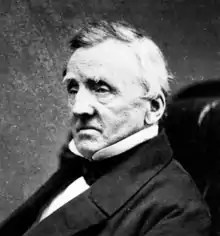Nathaniel Bagshaw Ward | |
|---|---|
 | |
| Born | 1791 |
| Died | 4 June 1868 |
| Occupation | Doctor |
| Known for | Inventor of the glass plant-cases |
Nathaniel Bagshaw Ward (1791 – 4 June 1868 in St Leonard's, Sussex) was an English doctor who popularised[1] a case for growing and transporting plants which was called the Wardian case.
Biography
Ward was born in London to Stephen Smith Ward, a medical doctor. Little is known of his early years and family life, but he is believed to have been sent to Jamaica at the age of thirteen where he may have taken an interest in plants. He practised medicine in a poor area of the East End of London and took an interest in botany and entomology in spare time or when on vacation in Cobham, Kent. Tyler-Whittle in his book, The Plant Hunters, describes the area where he lived:
What is known is that Wellclose Square, that part of dockland where he lived, was a Sherlock Holmes sort of place; not exactly producing lepers, abominable lascars and wicked Chinamen, but giving that impression all the same. And had Holmes and Watson been acquainted with their contemporary, Dr. Nathaniel Ward, undoubtedly they would have admired his scientific method of observing and deducing.[2]
Ward qualified as a member of the Royal College of Surgeons in London in 1814,[3] then later became a fellow of the Linnean Society in 1852.
His four sons, Stephen (born 1819), Nathaniel (born 1821), John (born 1824) and Richard (born 1831) all went on to qualify as doctors and surgeons. Stephen and Nathaniel after qualifying both worked as assistants with their father at the family East End practice. John joined the Royal Navy in 1846 as an assistant surgeon,[4] serving with distinction on HMS Vengeance during the Crimean War, with the youngest son Richard having his own practice in Central London.[3]
Ward and the Wardian case

Ward first noticed the effects of a hermetically sealed glass container in 1829. He had placed a chrysalis of a sphinx moth in damp soil at the bottom of a bottle and covered it with a lid. A week later he noticed that a fern and grass seedling had sprouted from the soil.[5] His interest piqued, he saw that evaporated moisture condensed on the walls of the bottle during the day, and ran back down into the soil towards evening, maintaining a constant humidity.[6]
The glass case that he used to rear butterflies and grow plants was used widely during the time for introducing plants into the British colonies. His first experiments with plants inside glass cases started in 1830. In 1833 George Loddiges used Wardian cases for shipping plants from Australia and said that "whereas I used formerly to lose nineteen out of the twenty of the plants I imported during the voyage, nineteen out of the twenty is now the average of those that survive". Loddiges was the vice-president of the Horticultural Society and Wardian cases became popular.

He attempted to make a greenhouse at the Clapham garden on the principle of the Wardian case. This was however critiqued by John Lindley in the Gardeners' Chronicle, who wrote that "when it is opened and shut from day to day, it has no more right to the name [of Wardian case] than a common greenhouse". Lindley also wrote saying that Ward had an inordinate vanity and a desire to be "recognised [as] a second Newton".
Dr Ward delivered a lecture on his discovery of a way to preserve plants in 1854 to the Royal Society at the Chelsea Physic Garden. He also worked on microscopy and helped in the development of the Chelsea Physic Garden as a member of the board. He was elected a fellow of the Royal Society in 1852.[7]
Nathaniel Bagshaw Ward died at St Leonards in Sussex and is buried in an unmarked grave in West Norwood Cemetery.
He was honoured in 1837, when botanists William Henry Harvey and William Jackson Hooker named a species of moss from South Africa after him, Wardia.[9]
References
- ↑ Allen 1969, pp. 8–9 states "Ward, despite universal statements to the contrary, was not in fact the first inventor of the glass plant-cases with which his name has become so indelibly associated."
- ↑ Tyler-Whittle, Michael Sidney (1997) [1970]. The Plant Hunters: Being an Examination of Collecting with an Account of the Careers & the Methods of a Number of Those who Have Searched the World for Wild Plants. Lyons & Burford. ISBN 978-1-55821-592-4.
- 1 2 The Medical Register. 1859, p312.
- ↑ Royal Navy Officer Service Records, National Archives, ADM/196/9.
- ↑ Keogh, Luke (2020). "(Book abstract) The Wardian Case". University of Chicago Press books. abstract. Retrieved 12 April 2021. (URL is the book's advertisement)
- ↑ "The Fever Trail" - Mark Honigsbaum (MacMillan 2001)
- ↑ "Ward; Nathaniel Bagshaw (1791 - 1868)". The Royal Society. Retrieved 5 December 2023.
- ↑ International Plant Names Index. N.B.Ward.
- ↑ "Wardia hygrometrica | PlantZAfrica". pza.sanbi.org. Retrieved 28 July 2022.
Other sources
- Allen, D.E. (1969). The Victorian Fern Craze. London: Hutchinson.
- Allen, D.E. (1976). The Naturalist in Britain - A Social History. London: Allen Lane.
- Desmond, Ray (1979). "The problems of transporting plants". In Harris, J (ed.). In The Garden: a Celebration of One Thousand Years of British Gardening. London. pp. 99–104.
{{cite book}}: CS1 maint: location missing publisher (link) - Hooker, J.D. (1868). "Nathaniel Bagshaw Ward, FRS, FLS". The Gardeners' Chronicle: 655–656.
- Minter, S. (2002). The Apothecaries' Garden: a History of the Chelsea Physic Garden. London: History Press.